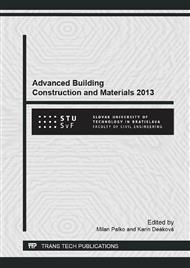p.25
p.31
p.35
p.39
p.43
p.47
p.52
p.57
p.62
Analysis of Energy Balance in Elementary School Building
Abstract:
One option to meet the requirements of Europe 2020 is construction of energy efficiency buildings. These buildings are low heat energy demand, which is influenced by various factors. The article describes the impact of different operating modes on the heat demand for heating in the building of the pavilion elementary school. The impact was assessed in simulation calculation program. The aim was to obtain knowledge about the behavior of the building in terms of thermal comfort in different operating modes during the heating season. The knowledge gained will enable more effective operation of HVAC systems. Increased efficiency of operation allows energy savings.
Info:
Periodical:
Pages:
43-46
Citation:
Online since:
December 2013
Authors:
Price:
Сopyright:
© 2014 Trans Tech Publications Ltd. All Rights Reserved
Share:
Citation:


